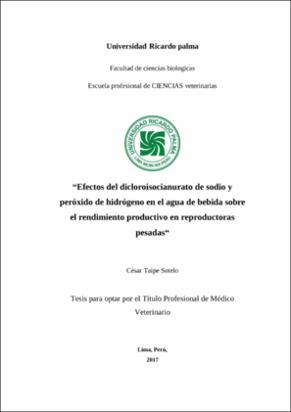| dc.contributor.advisor | Herrera Espinoza, Ana María | |
| dc.contributor.author | Taipe Sotelo, César | |
| dc.date.accessioned | 2018-06-01T14:34:43Z | |
| dc.date.available | 2018-06-01T14:34:43Z | |
| dc.date.issued | 2017 | |
| dc.identifier.uri | https://hdl.handle.net/20.500.14138/1423 | |
| dc.description.abstract | La presente investigación se realizó con el fin de evaluar los efectos de
los desinfectantes en el agua de bebida sobre el rendimiento productivo
en reproductoras pesadas, por ser la calidad del agua un factor
importante en la avicultura. Se utilizaron 3 grupos (2 tratamientos y 1
control) de 12,000 aves cada uno, reproductoras de 4 semanas de edad.
Para el primer tratamiento se usó una tableta de dicloroisocianurato de
sodio en 1,000 litros de agua; en el segundo tratamiento se usó una dosis
de 100 mililitros de peróxido de hidrógeno en 1,000 litros de agua; y en el
grupo control se usó agua sanitizada por la empresa. El
dicloroisocianurato de sodio y el peróxido de hidrógeno se obtuvieron con
los nombres comerciales que se encuentran en el sector avícola. Los
sanitizantes fueron administrados en el agua de bebida en el tratamiento
1 y 2 durante 4 semanas. Se empleó un diseño por bloques completos y
aleatorizado. Las variables en estudio fueron: peso, ganancia de peso
corporal, mortalidad, calidad de cama, calidad de heces y niveles de
amoniaco para los 2 tratamientos y control. Los resultados se obtuvieron a
las 7 semanas y demostraron que en el grupo control y en los 2
tratamientos, las aves no fueron afectadas en el peso, ganancia de peso y
mortalidad habiéndose adicionado los sanitizantes en el agua de bebida;
mientras que en la evaluación sobre la calidad de cama, calidad de heces
y niveles de amoniaco se encontraron mejores resultados cuando fueron
tratados con peróxido de hidrógeno. La conclusión fue que el peróxido de
hidrógeno al aportar oxígeno al medio anaerobio intestinal, mejora la
condición fisiológica de las aves a nivel del intestino delgado,
favoreciendo la absorción de nutrientes y afectando positivamente el
estado de la cama y ambiente.
The present investigation was realized in order to evaluate the
effects of disinfectants in the drinking water on the productive performance
on broiler breeder, because water quality is an important factor in poultry
farming. Three groups (2 treatments and 1 control) were used of 12,000
birds each, for the first treatment, a tablet of sodium dichloroisocyanurate
was used in 1,000 liters of water; in the second treatment a dose of 100
milliliters of hydrogen peroxide was used in 1,000 liters of water; and in the
second treatment Control group used sanitized water by the company.
Sodium dichloroisocyanurate and hydrogen peroxide were obtained by the
commercial names found in the poultry sector. Sanitizers were
administered in drinking water in treatment 1 and 2 for 4 weeks. A
complete randomized block design was used. The variables studied were:
weight, body weight gain, mortality, bed quality, stool quality and ammonia
levels for the 2 treatments and control. The results were obtained at 7
weeks and showed that in the control group and the 2 treatments. the
birds were not affected in weight, weight gain and mortality with the
addition of sanitizers in drinking water; While in the assessment of bed
quality, faeces quality and ammonia levels found better results when
treated with hydrogen peroxide. The conclusion was that hydrogen
peroxide by providing oxygen to the intestinal anaerobic environment
improves the physiological condition of the birds at the level of the small
intestine, favoring the absorption of nutrients and affecting positively the
state of the bed and environment. | es_ES |
| dc.description.sponsorship | Submitted by Wong Rafael (rafel_wl@hotmail.com) on 2018-06-01T14:34:43Z
No. of bitstreams: 1
Taipe_c.pdf: 1248848 bytes, checksum: b37fb88b3a87ef6b93e1258aec7f1d64 (MD5) | es_ES |
| dc.description.sponsorship | Made available in DSpace on 2018-06-01T14:34:43Z (GMT). No. of bitstreams: 1
Taipe_c.pdf: 1248848 bytes, checksum: b37fb88b3a87ef6b93e1258aec7f1d64 (MD5)
Previous issue date: 2017 | es_ES |
| dc.description.uri | Tesis | es_ES |
| dc.format | application/pdf | |
| dc.language.iso | spa | |
| dc.publisher | Universidad Ricardo Palma - URP | es_ES |
| dc.rights | info:eu-repo/semantics/openAccess | |
| dc.rights.uri | https://creativecommons.org/licenses/by-nc-nd/4.0/ | |
| dc.source | Repositorio Institucional - URP | es_ES |
| dc.subject | Calidad del agua, | es_ES |
| dc.subject | sanitizantes | es_ES |
| dc.subject | dicloroisocianurato de sodio | es_ES |
| dc.subject | peróxido de hidrógeno | es_ES |
| dc.subject | parámetros productivos | es_ES |
| dc.subject | aves | es_ES |
| dc.subject | Water quality | es_ES |
| dc.subject | sanitizers | es_ES |
| dc.subject | sodium dichloroisocyanurate | es_ES |
| dc.subject | hydrogen peroxide | es_ES |
| dc.subject | productive paramete | es_ES |
| dc.subject | birds | es_ES |
| dc.title | “Efectos del dicloroisocianurato de sodio y peróxido de hidrógeno en el agua de bebida sobre el rendimiento productivo en reproductoras pesadas“ | es_ES |
| dc.type | info:eu-repo/semantics/bachelorThesis | |
| thesis.degree.discipline | Medicina Veterinaria | es_ES |
| thesis.degree.grantor | Universidad Ricardo Palma. Facultad de Ciencias Biológicas. Escuela Profesional de Ciencias Veterinarias | es_ES |
| thesis.degree.level | Título Profesional | es_ES |
| thesis.degree.name | Médico Veterinario | es_ES |
| dc.publisher.country | PE | es_ES |
| dc.subject.ocde | https://purl.org/pe-repo/ocde/ford#4.03.01 | |
| renati.type | https://purl.org/pe-repo/renati/type#tesis | |
| renati.level | https://purl.org/pe-repo/renati/nivel#tituloProfesional | |
| renati.discipline | 841016 | |
| dc.type.version | info:eu-repo/semantics/publishedVersion | |


